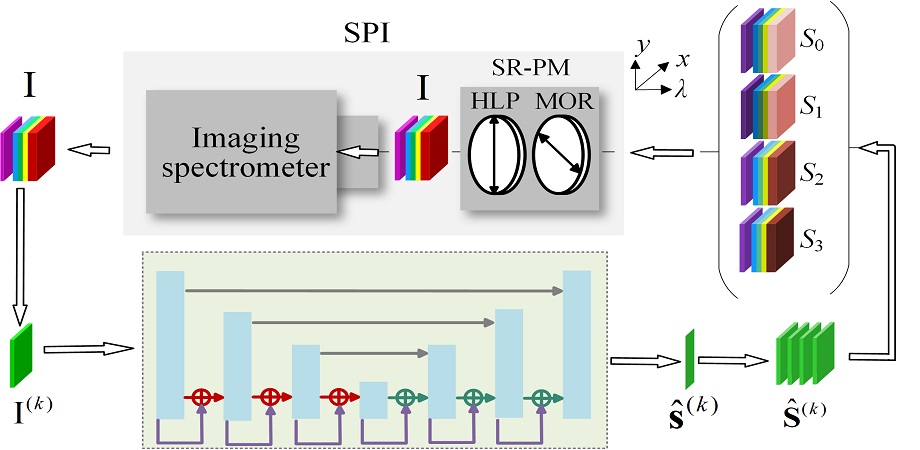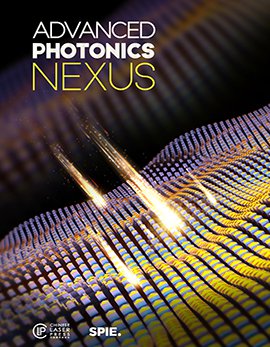
Spectropolarimetric imaging (SPI) scheme for the acquisition of high-dimensional 3D data cubes for each Stokes parameter. Credit: Han et al., doi 10.1117/1.APN.2.3.036009
In the world of optics, capturing high-dimensional optical information is crucial for understanding and characterizing various targets across different scenes. This includes important aspects like irradiance, spectrum, space, polarization, and phase. However, finding a single system that can gather all this information efficiently, while also being lightweight, portable, and cost-effective, is quite challenging.
Enter compressive full-Stokes spectropolarimetric imaging (SPI) — a powerful technique that integrates a passive polarization modulator (PM) into a general imaging spectrometer. This approach allows high-dimensional information to be captured from incomplete measurements. The only catch is that we need a reconstruction algorithm to recover the 3D data cubes (x, y, and λ) for each Stokes parameter describing the state of electromagnetic radiation. Unfortunately, existing PMs are complex and require accurate polarization calibration, and current reconstruction algorithms often suffer from poor image quality and are sensitive to noise.
Fortunately, a team of researchers from Xi’an Jiaotong University in China has come up with an innovative solution. As reported in Advanced Photonics Nexus, they have developed a passive spectropolarimetric modulation technique using a single multiple-order retarder followed by a polarizer. Creating a unified forward imaging model for SPI, they propose a reconstruction algorithm that combines deep image prior and sparsity prior. The best part is that their method doesn't require training data or accurate polarization calibration, and it can simultaneously reconstruct the 3D data cubes while achieving self-calibration. This new approach, called DIP-SP, is highly robust to noise and significantly improves the quality of the reconstructed images.
To demonstrate the feasibility and effectiveness of their technique, the researchers integrated the simplest PM into a miniature snapshot imaging spectrometer, creating a single-shot SPI prototype. Through simulations and experiments, they have shown that their SPI scheme outperforms existing methods. The beauty of their approach is that it allows general spectral imaging systems to become passive full-Stokes SPI systems without altering their intrinsic mechanisms.
The advantages of the DIP-SP method are manifold. First, it enables the implementation of the simplest passive PM scheme, making encoding and decoding feasible. Second, it eliminates the need for additional training data and can be applied to diverse applications. Third, it eliminates the time-consuming search for a scene-dependent regularization parameter required in other methods. Fourth, the output of the neural network is physically constrained and interpretable, thanks to the use of the forward-imaging model. Lastly, accurate calibration of the measurement matrix is not necessary, and rough preliminary polarization calibration is acceptable. This method also has the potential to be adapted to other PM schemes by modifying the measurement matrix.
This proposed SPI scheme can be used in industrial inspection and machine vision, where snapshot capabilities are often required, and it also has potential applications in surveillance using micro unmanned aerial vehicles or ground vehicles. In the field of biomedical diagnosis, it can be conveniently adapted to various commercial microscopies such as fluorescence microscopy, confocal microscopy, ophthalmoscopes, endoscopes, and laryngoscopes.
Overall, the innovative DIP-SP method opens exciting possibilities for the development of miniature SPI systems, utilizing both free-space optical components and chip-scale integration with silicon photonic circuits or metasurfaces. Its simplicity, effectiveness, and broad range of applications make it a significant advancement in the field of optical imaging.
Read the Gold Open Access article by F. Han et al., “Deep image prior plus sparsity prior: toward single-shot full-Stokes spectropolarimetric imaging with a multiple-order retarder,” Adv. Photon. Nexus 2(3) 036009 (2023) doi 10.1117/1.APN.2.3.036009


